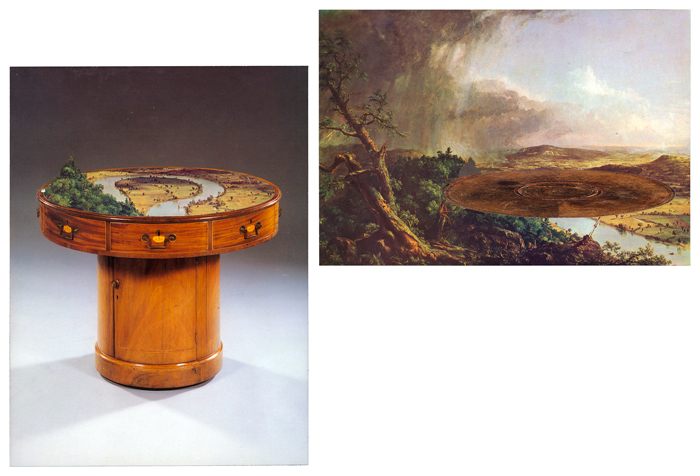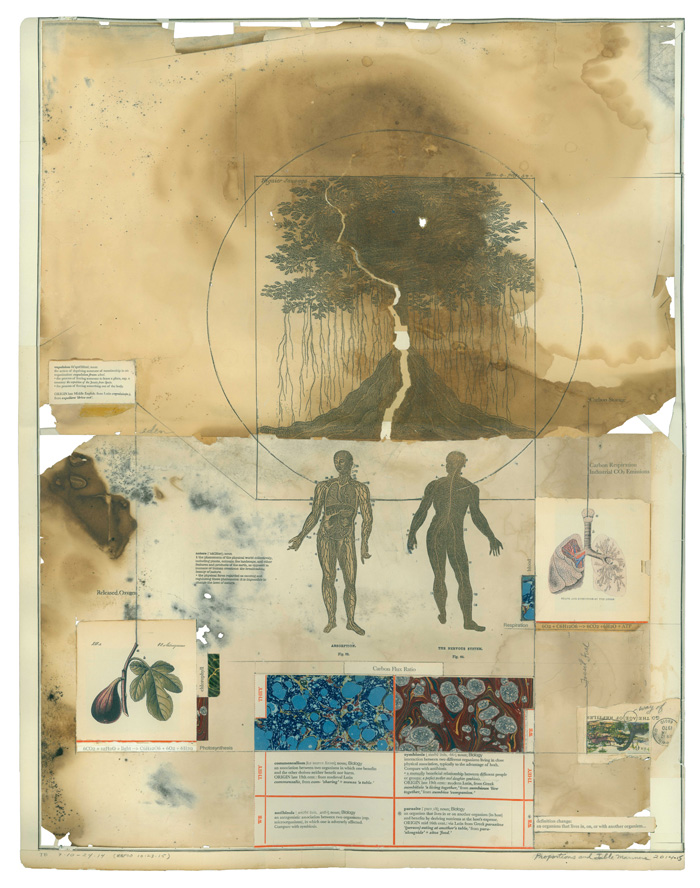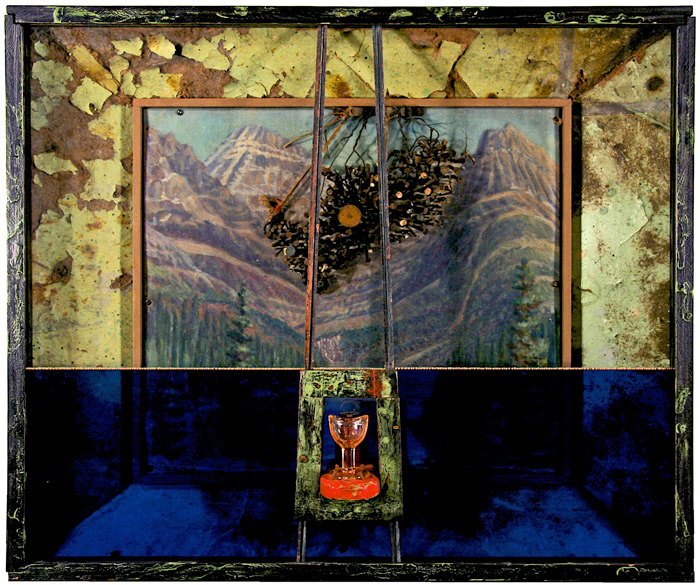Todd Bartel
 8.75″x17.125″; burnished puzzle-piece-fit collage, xerographic prints on nineteenth- and twentieth-century end-pages (left: How a Tree is Made into Lumber—lumberjack cutting a tree trunk into rectangular sections, Le Magasin Pittoresque, Larive and Fleury 1874; right: Clysmatica Nova, Joannes Sigismund Elsholtz 1667), pencil, map frame cuttings, wax paper transfer, Yes Glue, document repair tape; 2020 Todd Bartel STATEMENT The history of collage and the history of landscape painting are the same story. Since 1995 I have dedicated my artistic production to understanding and advocating for environmental concerns and the interconnected histories of these two genres of art production. In my drawings, collages, and assemblages, land depiction often appears in my work as marginalized or appropriated landscapes, or construct iconic “landviews.” My research-based studio practice questions the ways in which natural resources are consumed and how the surface of the planet is maintained. BIO Todd Bartel received a BFA in painting from Rhode Island School of Design concluding his studies at RISD’s European Honors Program in Rome, Italy (1985), and an MFA in painting from Carnegie Mellon (1993). He was a Jacob K. Javits Fellow in 1990 and received a Connecticut Council on the Arts Grant in 2000. Bartel has taught at Brown, Carnegie Mellon, and Manhattanville College among many others. He has been an MFA guest critic at RISD & Vermont Collage and New Hampshire Art Institute since 1998. He teaches drawing, painting, collage, and conceptual art at the Cambridge School of Weston (MA) and is the founder & Gallery Director of the Thompson Gallery, now in its 14th year. His work has been exhibited nationally at Palo Alto Art Center, Katonah Museum, Brockton Art Museum, The Rhode Island Foundation, Zieher Smith (New York), Mills Gallery (Boston, MA), Iona College among many others. His work is in the collections of the Kanyer Collection, the Ontological Museum, Pfizer, Carnegie Mellon University, New Haven Paint and Clay Club, MERZ Gallery, and numerous private collections. His collage-based work examines the roles of landscape and nature in contemporary culture. ARTIST CONTACT [click to email] IMAGES  10.625″x7.875″; burnished puzzle-piece collage, watercolor, document repair tape, book page, auction house catalog page; 2018 On the right: Thomas Cole, Oxbow: The Connecticut River Near Northampton, 1846 with A Library Table Top, George III, circa 1790, (A Tabletop for Mark Tansey) [Witness Series 11.b] 6.75″x9.75″; burnished puzzle-piece collage, watercolor, document repair tape, book page, auction house catalog page; 2018  24.5″x19.125″; burnished, puzzle-piece fit collage, 19th-century papers, end pages, marbled papers, Xerographic prints on antique end pages, toner transfers on rain eroded bulletin board papers, canceled stamp and envelope remnant, pencil, antique cellophane tape, archival document repair tape, yes glue and dictionary definitions; 2014  27.5″x23.25″x4.5″; tempera and casein on constructed wood box; fire-ravaged Masonite from the burned ruins (2001) of Paul Molinelli’s home in Vermont; rusted nails hammered into glacier area of discarded landscape painting (signed front); mustard seeds between layers of glass; eyewash cup, and mercury, glass globe; 2002  55.375″x22.625″x1.25″; computer-cut mat board, etched glass bearing the word “remember,” mustard seeds between three layers of glass, copper tape with patina, artist-made frame; watercolor, ink, Craypas, tempera, charcoal and blood on two pages from Ovid’s Metamorphosis, with collage on 19th-century engraving; tempera and watercolor over Xerox transfers (text from Genesis 1- 3, & 26) on 19th-century book end pages; 2002 |
